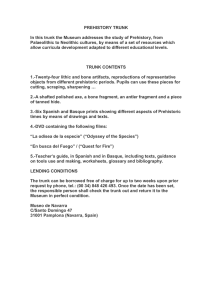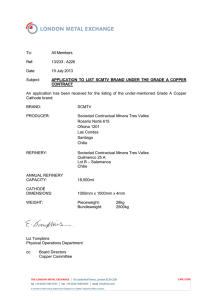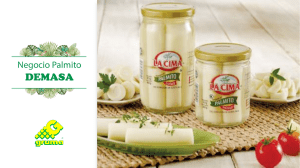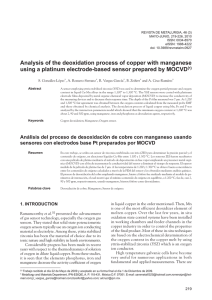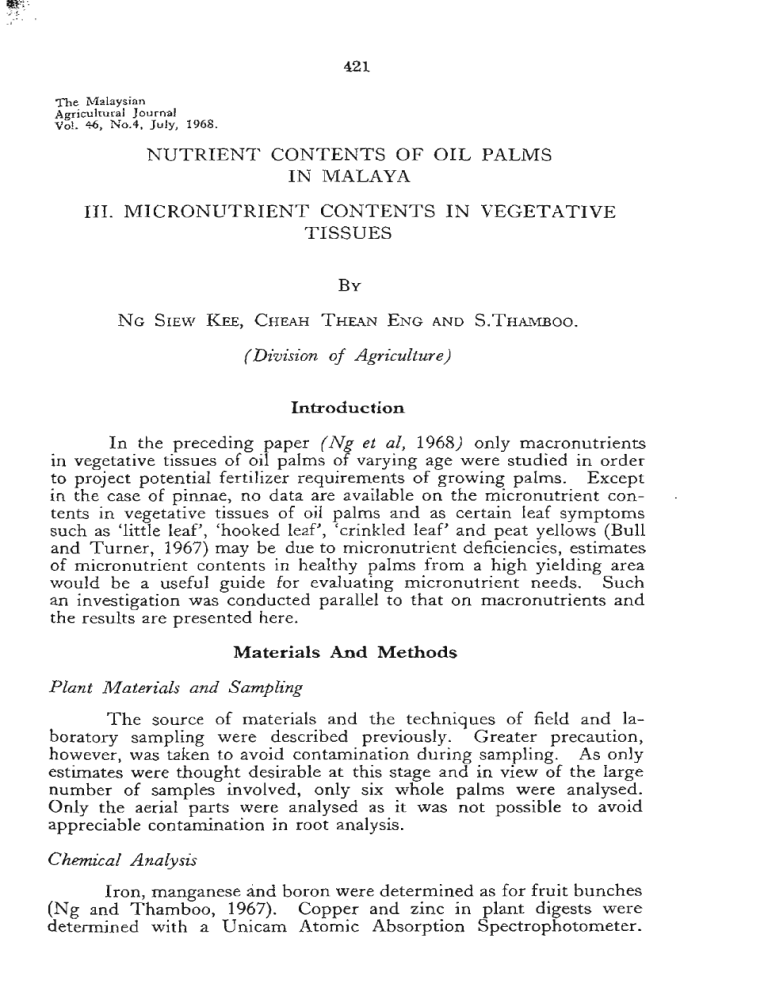
421
Th e Malaysian
Agricultural Journal
Vol. 46, No .4, July, 1968.
NUT RIENT CON TENTS OF OI L PALMS
IN MA LAYA
III. M IC RONUTRIENT CONTENTS I N VEGETATIVE
TISSUES
NG SlEW KEE, CHEAH T H EAN E N G AN D S .T HAMBoo.
( Division of Agriculture)
Introduction
In the pre ceding paper (Ng et al, 1968) only macronutrients
in vegetative tissues of oil palms of varying age were studied in order
to project potential fertil izer req uirements of growing palms. Except
in the case of pinnae, no data are available on the micronutrient contents in vegetative tissues of oil palms and as certain leaf symptoms
such as 'little leaf', 'hooked leaf', 'crinkled leaf' and peat yellows (Bull
and Turn er, 1967) may be due to micronutrient deficiencies, estimates
of micronutrient contents in healthy palms from a high yielding area
would be a useful guid e for evaluating micron ut rient needs. Such
an investigation was conducted parallel to that on macronutrients and
the results are presented here .
Materials And Methods
Plant Materials and S ampling
The sour ce of mate rials and the techniques of field and laboratory sampl ing were described previously. Greater precaution,
however, was taken to avoid contamin ation during sampling. As only
estimates were thought desirable at this stage and in view of the large
number of samples involved, only six whole palms were analysed.
Only the aerial parts were analysed as it was not possible to avoid
appreciable contamination in root analysis.
Chemical Analysis
Iron, manganese and boron were determined as for fruit bunches
(Ng and Thamboo, 1967). Copper and zinc in plant digests were
determined with a Unicam Atomic Absorption Spectrophotometer.
423
422
Table 1
Results
Mean Micronutrient Concentration in Plant Tissues. (P.P.M. of Dry Matter)
Mean Nutrient Composition in Major Components
Crown
&
Trunk
The mean results for the major tissues are presented in Table 1.
Boron
On the whole, levels for the crown were comparable to those
of the whole trunk. Within the crown, cabbage values were highest
and those of rachis were the lowest. There was no distinct difference
between the inner and outer portion of the trunk. There were no
trends with age in crown tissues but in the trunk, boron concentration
tended to decline with age.
10.7
6.4
10.0
13.8
7.2
8.0
40
10.5
6.6
8.0
15.4
8.9
8.3
64
9.3
6.3
8.0
14.7
8.1
7.8
104
12.1
7.2
6.9
25.1
8.2
8.4
129
11.4
7.2
8.'
18.9
6.7
7.2
9.7
6.4
8.0
18.4
6.6
7.1
6.0
15.0
23.0
8.0
40
6.6
6.3
9.4
20.5
10.2
64
6.5
6.'
9.7
32.8
8.3
14
160
14
Copper
Copper values were of the order of those of boron except in
the cabbage. Trunk values were slightly greater than those of
the crOWD. Within the crown, the cabbage had the highest concentration, being 4-5 times as much as those of pinnae and rachis. In
the trunk, there was a higher level of copper in the inner portion.
No overall trends with palm age could be discerned.
Zinc
Except in the rachis, zinc levels were higher than those of boron
~nd copper. In contrast to boron and copper, zinc levels were higher
in the trunk than in the crown. Within the crown, the order of concentration was cabbage> spear> pinnae> rachis. Cabbage levels
were considerably higher than those of the other crown tissues. Within the trunk, the inner portion was richer in zinc. Only the spear
displayed a decreasing trend with age.
Manganese
Except in the cabbage and inner trunk, manganese levels were
generally greater than those of zinc. However, mean values for the
crown and trunk exceeded appreciably those of zinc. As in the case
of zinc, levels for the crown were greater than those of the trunk as
a whole. Within the crown, pinnae levels were the highest, contrary
to results for boron, copper and zinc. Rachis values were the lowest
while those of the cabbage and spear were comparable. Within the
trunk, the inner portion was richer in manganese in the younger stage
but in older palms the position was reversed. Levels in the youngest
palm were generally lower but there were no clear trends with age.
B
Cu
10'
6.1
6.1
11.0
24.0
6.5
10.6
8.7
9.0
8.0
129
6.8
6.5
10.8
23.7
6.9
11.5
8.8
9.5
8.9
160
6.3
6.4
11.1
30.8
6.7
8.1
6.7
6.9
6.9
12.7
6.8
37.7
214
24
40
12.2
7.8
30.0
106
10.4
106
14
Zn
29.0
25
27.7
38.2
22.8
30.7
64
17.3
7.7
23.6
194
13.5
140
13.5
45.1
104
12.0
7.6
22.4
153
io.s
112
19.1
35.4
25.7
129
9.1
6.1
14.1
70
7.8
55
9.7
21.5
18.0
160
8.1
4.7
14.1
140
7.0
109
17.6
32.7
26.7
120
43
72
25
64
14
Mn
163
30
40
352
81
148
146
161
64
125
116
141
6'
540
113
146
155
250
68
98
96
166
104
300
73
116
157
143
42
74
69
98
129
221
61
102
62
114
33
44
41
60
44
48
47
74
226
107
405
398
221
160
314
81
136
136
162
77
85
62
67
81
4{)
67
84
40
54
77
350
14
Fe
64
101
68
41
91
77
253
235
239
166
104
70
30
47
87
43
212
303
243
165
129
96
36
57
69
56
154
161
159
134
160
71
37
54
109
50
139
197
187
156
II
I
1
424
Ir on
In the t run k, iron concentrations were great er than those of
mangan ese but in crown tissues they were lower. Within the crown,
the ord er of concentration was pinna e > cabbage > rachis/spear.
Withi n the trunk, there was no discernible difference between inner
and ou ter portion. The rachis and crown as a whole showed definite
declines in levels with age.
M icronutrient Composition Wit hin Tissues
Fronds
Fig. 1 illustrates micronutrient concentrations in pinnae of
fronds 1, 9, 17, 25 and 33.
Manganese and iron levels were considerably greater than the
rest and copper values tended to be least. Pinnae values did not
depict definite trends with age of palm. On t he oth er hand , within
palms, copper and zinc levels tend ed to decline with frond age while
manganese and iron showed th e opposite trend . Boron values were
rather variable and no consistent trend could be seen. T hese results
are intriguing as it is generally found that micronu trients in plants
are rather immob ile and their concentrations -are consequently lower
in younger tissues. Obviously, the behaviour of rnicronutrients in
the oil palm is mor e complex th an may be assu med from general
physiological knowledge.
425
I
i
!
I
I
,i,
.
i
1
"
" '"
•
B
..
"
..••
~
.•
,
~
"
~ iJM, t !t
'"
Trunk
Results for the ar bitrarily divided segments of the trunk s are
shown in T able 2. In th e case of boron and manganese, the cabbage
had th e high est concent rations. With th e exception of iron, the
up per port ions of th e tru nk were richer in micron ut rients than the
lower segments . Differences between inner and outer portions were
not distinct except in th e case of zinc. In th e case of copper, only
in the upper segments of the trun k were ther e differences between
inner and outer portion.
Total Nutrient Uptake
T able 3 shows data on total micronutri ent conte nts in th e aerial
part s of palms of varying age.
"
"
..
•
'"
-
~
e>
".
"
"
~
"
Rachis
As in pinn ae. manganese and iron concent rations were
higher t han tho se of th e ot her element s. Copper and zinc levels declined
with frond age within palms while other elements showed no clear
trends. (Fig. 2).
,- .
~
".
•
•
•
·
• z.
.. "
re
' -- -
.
:",, -.. ---,, :..: =:oo~
~-""====~~;:;; !:::
"
(PINNAE)
Fig. I
Mic ro nutrie nt con ce nt ra t ion i" p innlul of h onds 'n l i_ p"l ms fro m r-4. IM> "',ol'lffos old in l~a
fielu (p arh pe r million of d ry maH erj
426
427
Tnble 2
Mierc nut rien t Concentration I n Segments Of Oil Palm Trunk
(P. P.M. of D ry Basis)
•
,~
Cu
Segmen t
Fi eld Age
Of Pa lms
I or
,,,
I
40
"
(M onths)
T runk
14
Ca bb age
, Cabba~
,,,
•
·
2nd
64
:r
•
•
e
.
.
,,,
2nd
_••••_. 'ZI
"
I
,ro
I
104
"
Cabba ge
3rd
12.3
7.0
Bottom
5.9
8.0
Cab bage
,,,
9.6
2nd
"
11.4
••
7.3
129
:1
.
.. ,
19.2
es
"~O'<!l HU " ~ E ~
'1
~
11 "
j~~,""
Fig . 2
Mil;. onu lr'.n l t one- nlra tion in re chis of fronds in si~ plllms h om J4·l bO mon ths old in the
field (pd rts p er million of d ry motter!
10. 3
86
94
285
219
16.0
87
112
310
277
I
1150
~':I157--1, - :- 87 :-~ 1 ~ 1 49
j 24 f 43
Botto n,
160
Ca bb age
130 1 165
71
231
72
279
250
' 88
~_I8_~I--:"" I "":.:..:...j
330
76
1~: 111 I : ...
220
69
8,2
12 5
10.5
9:5
80
4-4
44
110
150
170
170
::
:~ I ;: I ::
42
45
150
170
4,8
"jM"~/,
·':1'
104
66.9
6.6 63114 1 40
.IU
..
I
5.5
30.8
2
112'5
J
150
109
150
1--
,,,
18.4
6,9
6.7
38.2
9.5
359
180
48
so
150
162
2" d
3.5
5.9
3,9
6.9
124
24.7
40
38
lS I
192
140
' 36
3,d
3.5
6.0
2.6
7.2
41.7
16.9
43
46
102
209
Bott om
5.1
1.4
2.4
3.4
29.3
11.7
49
56
147
227
N.B.
a
I nn er, soft portion.
b
Ou ter , bard po rtion.
428
T.bl ~ J
Micronutrie nt Cornenll Of Palm Com ponen ts (lPlrli,.lm)
P. lm
...
I
Pinno<
lUoh>
Ca bb.age
'- '
T ru.nk
31
41
11
16
228
au
as
54l
1128
143
53
925
1638
72
1850
3095
'" ,
2"
( M cn tlu)
14
COPP ER
BORON
A .. Of
782
'"
...
I
Speu &;
c.bbtli"
T ota l
Pinna e
Ra cltiJ
99
"
38
18
'"
565
"
I
"
204•
10.
381
..." I
129
458
572
76
2591
3697
273
51.
97
160
51.
615
85
3291
4505
m
61.
121
I
I
I
Pima.
99
31
41
163
1392
266
I ."." II
123
. 85
152
1743
52.
50.
3671
4555
367
3668
47 38
429
I
10'
I
Spur &
Cl1booVC
T Olll
2972
1086
50'
I
Tnook
,
l
Z 1N C
IU""
I
T nm k
I
T~I
" !
308
.81
2323
3108
7616
306
5162
..51
t 6365
269
8021
9492
,12632
I ' SO I 240
8256
29.
I
I
17266
I,
I
I RON
MA N G A NES E
I Rach is
:h nM"
19S
P inn.ae
Rachis
'_&
Cabbart
Tr unk
ss
,,,
31
."
1,.328
' 30
708<l
19229
'"
344
1462
4253
124
241g6
30,025
10963
l4 9J7
3063
407.
292
27423
34,854-
1060
15611
36065
2962
2741
445
551>45
61,193
I'-'
Cabba~
"
"" I 862
I
I
6747
6762
Tnmk
T ow
Total
9260
8886
4872
819
15949
30526
3877
2886
48'
61321
68,578
18385
16636
7825
1302
25095
50858
3804-
3562
572
98988
106,926
," iII. .
"""', ~'l,;r.;.
"
-; "'
.:
429
Total boron, copper and iron contents increased with paln. age
for the period studied but for zinc and manganese, this increase was
seen up to only 104. months. Thereafter, the estimates for these two
elements were erratic, due probably to samplmg error. Most of the
increase was accounted for by net increment in the trunk. The trunk
contents showed a consistent rise with age but in the case of pinnae
and rachis, estimates for the adult palms (104 and 160 months old)
were less consistent, and this can be summarized as follows:(a)
B
No appreciable change in pinnae and rachis
contents
(b)
eu
Slight increase m pmnae values
appreciable change in rachis.
(c)
Zn
A decline in both pinnae and rachis values.
(d)
Mn
Variable contents in pmnae and rachis.
(e)
Fe
Increase in pinnae and rachis.
but
no
Percentage Distribution of Total Contents
The distribution of total contents in the aerial portion of the
palm is illustrated in Fig. 3. It can be seen that except for manganese,
the trunk content became predominant by about the 30th month.
For manganese, this took place round about the 9th year. 'While
trunk values increased with age, those of other tissues declined. The
. rates of change were greater in the early years. A much larger proportion of total manganese was found in the pinnae than was the case
with other micronutrients. In all cases except manganese, rachis
contents were second highest.
Estimates of Micronutrient Contents in Adult Palms and Fruit Bunches
The absolute quantities of micronutrients in palms are likely
to increase with age as has been found for the macronutrients. However, as it is useful to know what contents mature palms may possess,
the data of the 104 - 160 - month old palms are used to derive average
estimates of micronutrient contents in an assumed number of mature
palms. Such data are presented in Table 4, together with estimates
previously obtained for fruit bunches.
These data indicate that in terms of reserves for production
of fruit bunches the palms had better reserves of iron, manganese and
zmc than boron and copper. Iron reserve can be said to be the highest
while that of copper least.
430
80
431
Table 4
B
Es t im at es o ( T ot a l M icronu trient Con ten ts in 9-13 Year Old Palms (m in us roots)
O n Coastal Cla y
Mn
6
Kg
M a ter ial
Q uant ity
B
40
'Yo
"'1=
'0
F.F.B.
<,
• •
40
Palms/F.F.B ratio
80
AGE. ( J,4 0 ~ Ttl Sl
120
,60
80
'0
AGE ( MONT HS)
120
. ffi O
60
0.226
to tons
0.022
10.3
i
,I
!
Cu
I
Zn
I 1'1.
F.
0.225
0.743
2.349
4.751
0.048
0.049
0. l S1
0.247
15.2
15.5
19.2
I ' .7
D iscussion
8
Fe
Cu
As only a small numbe r of palms were analysed, some of the
80
conclus ions dr awn can onl y be tentative, particularly on th e quantitative
aspec ts .
60
Withi n palms, fairly definite trends of nutrient concentrati on
were established. T he cabbage gener ally had higher concentr ations
of micronutrients than other tissues and th is is not surprising as it
is in the growing point of the palms in which micronutrienrs can be
expected to play an active enzymatic role. However, the precise
nature of this role has still to be discovered.
EO
'Yo
40
"10
' 0
40
~~
40
'0
AGE { MONTHSl
10
'0
160
S·
. 80
40
AGE (MONTHS)
100
120
Zn
80
L E AFL.ETS
60
'" RACHIS
"10
0
SPEAR a CABBAGE
•
TRUNK
40
' 0
40
60
AGE (MONT tl S)
J69
Fig. J
Distr ibuti on of ta h l m;cronu fri" nt co" t~nts in pIllms of ..." rying 1lge 1%1
G Iko
Unlike the macronutrients viz. nitrogen, phosphorus, potassium
and magnesium, micronutrients are generally known to be rath er
immobile and not easily translocated from older to youn ger tissues.
However, results of pinnae within palms indicat e that this probably
holds only for copper and zinc. Manga nese and iron appear to behave
in an opposite fashion while boron gave no clear tr end. In view of
such contrast ing modes, it is therefore doubtful if analysis of frond
17 can indicate satisfactorily the stat us of all micronutrients in mature
palms. It would appear that for diagnostic purposes a far more complex situati on is obtaine d in the case of micronutrients th an th e rnacronutr ients and furt her investigations are necessary to resolve this.
In the interim any {critical' levels set should be considered very ten tative.
It is not possible to evaluate precisely the imrlications of th e
results obtained for assessing micronutrient needs 0 palms in view
of inadequate data on the micronutrient status of West M alaysian soils
and experiments with trace elements. The data on total micronutrient
contents can only be used as approximate guides. Althoug h deficiency
symptoms of some micronutrients in oil palm seedling have been
established (Bull, 1961) such symptoms on older palms have not been
produced. experim entally. However, th ere is fair knowledge of some
432
433
micronu trient deficiency symptoms in the field. Symp toms such as
crinkled leaf, hooked leaf or little leaf are alleged to be due to a deficiency of boron bu t no direct pr oof of this is available. N evertheless,
experience has shown that app lication of a few oun ces of borax per
palm is generally known to remove t hese symptoms. I nference from
leaf analysis data indicates that boron problems are unli kely to occur
on coastal marine clays bu t ar e more likely to be confined to inland
For th e future, th ere is need to achieve bett er precision in leaf
nalysis techni qu es and diagnosis as the present meth od has obvious
rimitations. T he exact nature of deficiency sympt~ms of mi~ronu­
trieotS in field palms also needs to be defined by expen ments. Fin ally,
there is scope for t race element experiments on certain soi~s i.e. orga,nic
soils and those derived from older an d sub-recent alluv ium, granites
and sandstones.
soils in West Malaysia.
Summary
M anganese d eficienc y of ru bber has been found to be common
on older alluvial and granitic soils (Sborrc cks and Watson, 1961).
D ata on soil manganese (Ng, 1966 and Chang, 1968) confirm that
man ganese contents are low in soils derived from sub-recent and older
alluvium , granites, quartzite and some pale-colour ed shale soils. In
view of th e above facts and t he relatively large requi rement of manganese by the oil palm. a precautionary outlook on these soils is desirable. Although the nat ur e of manganese deficiency symptoms is
not definit ely known, leaf analysis can be used as a guide to forestall
any gross deficiency.
Much less is known about deficiency of copper in oil palms.
L eaf analysis data show that very low levels of coppe r of less than 5
parts per million in frond 17 are very common on peats. This is often
associated with yellowing of pinnae, especially at the tips of fronds.
On mineral soils, t hese symptoms have not so far been encountered.
There is hardly any information on the effect of copper applications
to palms on peat as apparently, suitable meth ods of application have
n ot been devised. As copper deficiency is almost universal on peats,
it may be potentially a maj or pr oblem of oil palm cultivation on peats
in M alaysia.
No information is available on zinc and iron deficiency symp toms
in oil palms . Of the two, iron deficiency is unlikely to be of any
significance as most West Malaysian soils have adequ ate iron contents.
Thus) the micronutrient uptake data presented here, considered
.n conjunc tion with existing knowledge from certain commo n deficiency sym ptoms, soil and leaf analysis, indicate that in oil palm
nutrition, the requ irements of micronutrients are likely to focus on
manganese, boron and copper in t he first place. T h ese req uiremen ts
are closely associated with soil conditions but on the whole are likely
to be more prevalent on inland and organic soils. As heavy manuring
to sustain large yields is becomin g a necessary practi ce on most soils
in this cou ntry with the exception of the mar ine clays, the depletion
of micron utrients will also be rap id. T herefore, th e chances of micronutrient shortages, especially th ose of manganese, boron and copper,
limiting produ ction can be very real. In this resp ect, the periodic
use of fertilizers cont aining these micronutrients can be judiciously
adop ted on an insurance basis.
Six ind ividu al palms varying from 1-13 years of age on Selangor
Series Soil were sampled and t he micronutrient contents in various
components were determined . The mean concentrations in the whole
aerial parts of palms were :-
,
ppm
B
Cu
Zn
Mn
Fe
7.2-8.4
6.9-10.2
18-30.7
60-166
107· 221
Within t he palm, the cabbage had the highest concentrations of nutrients except for manganese which was highest in pinnae. T he inner
trunk had higher concentrations of copper and zinc and the upper
segments of th e trunk tend ed .to have higher value:' than lower segments. I n pinnae, concentrations of cop per and ZInC decreased but
those of man ganese and iron increased with frond age. Boron levels
in pinnae showed no distinct tr end.
T otal qu antities of micronutrients in aerial part s of 60 ad ult
palms were estimated as followsr-c-
Kg
B
Cu
Zn
Mn
Fe
0.226
0.22
0.743
2.349
4.751
It was shown that in terms of fruit bunch production. the palms had
better reserves of iron , manganese and zinc than boron and copper .
The relation of these results to oil palm nutrition and manuring
was discussed .
Acknowle dgement
We expr ess our grate ful thanks to M essrs. B.S. Gray; and C. ~.
Hew, Oil Palm Research Station (H arrisons and Crosfield, M alaysia,
Ltd.), Banting, Selangor for their cooperation in this investigation
and to laboratory staff of the Soils Di vision for analysis.
434
References
1.
Bull, R.A. (1961) : 3. Micronutrient deficiency symptoms ill
oil palm seedlings grown in sand culture. ]L W. Afr.
Inst. Oil Palm Res. 3, 265.
2.
and P.D. Turner (1967) : Diseases and Disorders of
the Oil Palm. Incorporated Society of Planters, Malaysia.
3.
Chang Soo Kong: (Unpublished) Dept. of Agriculture.
4.
Ng. S.K. (1966) : 'Soils' in The Oil Palm in Malaya.
Edition. Min. Agric. and Coop, West Malaysia.
2nd
5.
and S. Thamboo (1967) : Nutrient Contents of Oil
Palms in Malaya 1. Nutrients required for Reproduction.
Fruit bunches and male inflorescence. Malaysian agric.
]nl46, (1), 3.
6.
and P. de Souza (1968) : Nutrient contents of oil
palms in Malaya II. Nutrients in Vegetative Tissue.
Malaysian agric. ]nl 46, (3), 332.
7.
Shorrocks, V.M. and G.A. Watson (1961) : Manganese deficiency in Hevea. The Effect of Soil Application of
Manganese Sulphate on the Manganese Status of the
Tree. ]. Rubb. Res. Inst. Malaya, 17, 19.
